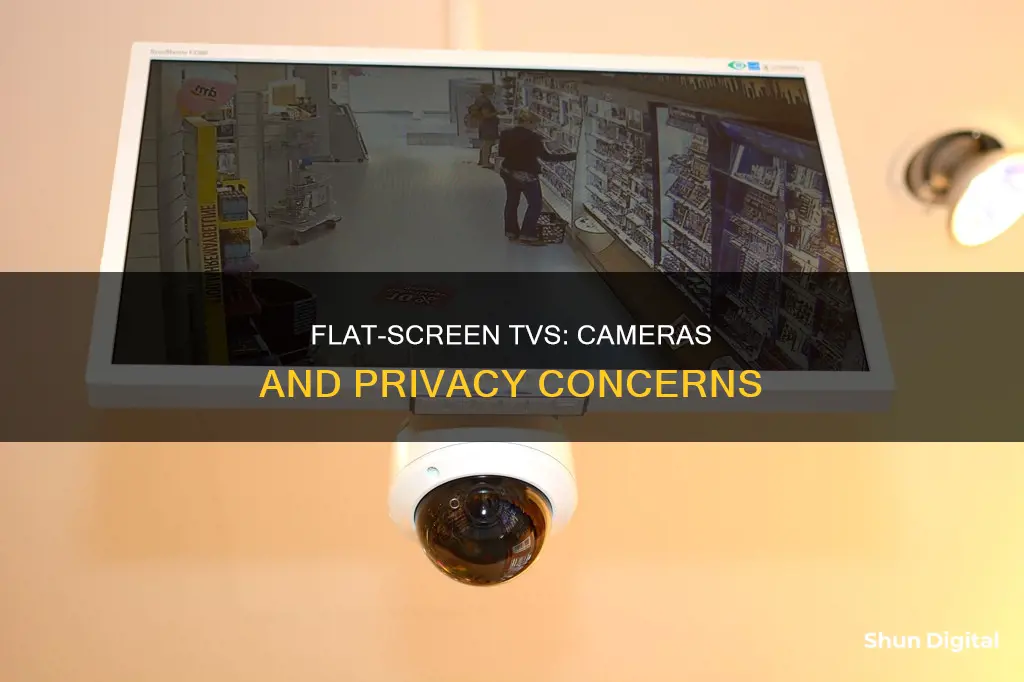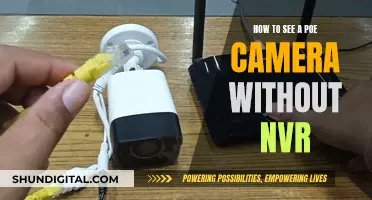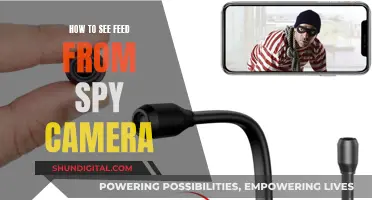
Flat-screen TVs have evolved from being passive receivers of visual information to becoming active devices with integrated camera functionality. This has raised concerns about surveillance and privacy violations, especially with the ability to capture images and videos of individuals in their homes. While many newer smart TVs contain cameras for features like facial recognition, they are typically not hidden. However, it is in a user's best interest to spot any hidden cameras, especially when buying second-hand TVs or those from unknown brands. This can be done by referring to the owner's manual or by looking for reflective circles or small black dots on the TV bezels.
| Characteristics | Values |
|---|---|
| Do flat-screen TVs have cameras? | Some newer smart TVs may contain cameras for features such as facial recognition, but they're not necessarily hidden. |
| How to spot a camera? | Most mainstream brands like LG and Samsung list all included cameras and microphones on the owner's manual. The owner's manual will also point out how many cameras and microphones are included and where each is located. Cameras in smart TVs are usually located at the upper edge of the TV bezel. You can identify hidden cameras by looking for a small reflective circle, which is the camera's lens. |
| How to stop smart TVs from recording you? | Research the features of your smart TV model, don't rush through the set-up settings, disable the camera and microphone, and get cybersecurity apps and software. |
What You'll Learn

Smart TVs with hidden cameras
- Examine the bezel or border of the TV: Most manufacturers place cameras in the bezel, which is the plastic frame around the screen. Look for a small reflective circle, which would be the camera lens. You can also shine a flashlight around the edges to spot any reflections from the lens.
- Refer to the owner's manual: The manual should list all the built-in cameras and their locations. It will also mention the number of cameras and microphones included.
- Search online: You can search for the model of your TV along with the word "camera" to see if any information comes up.
- Check for retractable lenses: Some smart TVs have retractable lenses that can be difficult to spot. Run your finger along the edges and bezel to feel for any small depressions or bumps that could indicate the presence of a camera.
It is important to note that smart TVs collect data about your viewing habits, even if they do not have built-in cameras. This data collection is often done through automatic content recognition (ACR) technology, which tracks the shows you watch to tailor content recommendations and advertisements. Additionally, some smart TVs can collect data through their cameras and microphones, so it is crucial to review the privacy settings and disable any unwanted data collection features.
To protect your privacy, you can take the following steps:
- Change default security settings: Use strong passwords and enable two-factor authentication if available.
- Stay up-to-date with software updates: Manufacturers often release security patches to fix vulnerabilities, so keeping your TV's software up-to-date is crucial.
- Review the privacy policy: Understand how your data is being collected, stored, and used by the TV manufacturer and streaming services.
- Physically block the camera: If you are not using the camera features, you can cover the lens with black tape or cardboard to prevent it from recording.
- Disable the camera and microphone: You can turn off the camera and microphone through the TV's settings to prevent any data collection through these features.
Stream Home Camera on Chrome: Easy Steps to Watch Remotely
You may want to see also

Spotting hidden cameras
Hidden cameras are an invasion of privacy and can put your personal safety at risk. They can be hidden anywhere, from hotel rooms to homes, and can be well-camouflaged. Here are some ways to spot hidden cameras:
Manual Inspection
- Use a flashlight to carefully scan the room, looking for tiny blue or purple reflections that could indicate a camera lens.
- Pay attention to small LED lights shining in a dark room, which could be a hidden camera.
- Look for objects that seem out of place, such as random stuffed animals in a modern Airbnb. Cameras can be hidden in inconspicuous objects like alarm clocks, smoke detectors, and picture frames.
- Inspect wires carefully, as they could be running to hidden cameras that require power.
- Search for small holes in walls, furniture, decor, and fixtures where a camera could be hidden.
- Test mirrors by placing your finger against them; if your finger and reflection seem to be touching tip-to-tip, it could be a two-way mirror or a hidden camera.
Smartphone Camera and Apps
- If your phone has an infrared light camera, open the camera and scan the room for small bursts of steady or flashing light, which could indicate a hidden camera.
- Use smartphone apps that combine technologies like Bluetooth scanning and infrared detection to find unidentified devices within range, such as hidden cameras using Bluetooth. Be cautious of downloading apps from third-party app stores to avoid malware.
Radio Frequency (RF) Detectors
RF detectors provide an audible or visual alert when they detect a hidden camera's signal, helping you locate it. These devices scan for radio frequencies emitted by hidden cameras and can be purchased online or in stores. Unplug other electronic devices before using an RF detector to avoid interference.
Infrared Scanners
Infrared scanners can detect the invisible infrared light emitted by certain night vision cameras. If you notice a faint glowing spot in a darkened room, it could be a camera lens reflecting the infrared rays.
Wi-Fi Network Scanning
Some hidden cameras connect to Wi-Fi, so if it's on the same network as you, you might detect it by scanning your wireless network for unrecognized or suspicious devices.
Public Camera Feeds: Are They Legal to Watch?
You may want to see also

Blocking camera and microphone
Smart TVs are great for their interconnectivity and personalisation, but they can also be a liability when it comes to your privacy. Smart TVs can collect a lot of data about your viewing habits, and this data is often sold to advertisers. In addition, cybercriminals can use your Wi-Fi network to hack into your smart TV and gain access to your smart home.
Understand the Features of Your Smart TV:
Start by doing a basic internet search of your TV model number along with the words "microphone," "camera," and "privacy." This will help you understand the specific features and settings of your TV.
Change Default Security Settings:
Don't rely on the default security settings provided by the manufacturer. Change passwords if possible and learn how to disable microphones, cameras, and personal data collection. If you can't turn these features off, consider getting a different TV.
Cover the Camera:
A simple and effective way to block the camera on your smart TV is to cover the lens with black tape or thick cardboard. If you can't find the camera, open a video chat app and move the piece of cardboard around until you block the screen. This will ensure that even if the camera is on, it can't record you.
Check for Security Patches:
Look into whether the smart TV manufacturer offers security patches and updates to protect your device from vulnerabilities. If possible, turn on automatic software updates to keep your TV secure.
Review Privacy Policies:
Check the privacy policy of your smart TV manufacturer and the streaming services you use. Understand what type of data they collect, how it is stored, and how it is used. This will help you make informed decisions about the data you share.
Disable ACR Technology:
Automatic Content Recognition (ACR) is a standard feature on most smart TVs that collects data about your viewing habits. You can turn off ACR on your TV by following the specific instructions for your TV brand and model. This will limit the amount of data collected about your viewing habits.
Disable Voice Recording:
If your smart TV has voice recognition or voice command features, you can turn off the voice recording feature. This will prevent the TV from listening to and collecting your voice data. The steps to disable voice recording vary depending on the TV brand and model.
Use Antivirus Software:
Consider installing powerful antivirus software, such as Avast One, to monitor your network for security vulnerabilities and block unwanted intrusions. This will help protect your smart TV and other connected devices from hackers and malware.
By following these steps, you can enhance your privacy and security while still enjoying the benefits of your smart TV. It's important to stay informed about the data your devices collect and take proactive measures to protect your personal information.
Galaxy Watch 4: Camera Expectations Unveiled
You may want to see also

TV screens as cameras
While flat-screen TVs with built-in cameras are available, it is also possible to purchase a separate webcam to attach to your TV.
External Webcams
Webcams can be attached to your TV to enable video conferencing. These are some examples:
- Logitech StreamCam Plus 1080 Webcam
- Razer Kiyo Pro 1080 Webcam
- Elgato Facecam Pro 4K60 Ultra HD Webcam
- Aluratek Live Ultra 2K HD Webcam
- Logitech Brio 500 1920x1080p Webcam
Flat-Screen TVs with Built-In Cameras
Some flat-screen TVs come with built-in cameras, which can be used for video conferencing. Here are some examples:
- Samsung Slim Fit Camera
- Samsung M8 Series 32-Inch 4K UHD Smart Monitor
- Samsung 27" M80C UHD HDR Smart Computer Monitor Screen
- Amazon Fire TV 50" 4-Series 4K UHD Smart TV
Watching Sports with HD DV SQ11 Mini DV Camera
You may want to see also

Ethical and privacy concerns
Flat-screen TVs, particularly smart TVs, have become increasingly popular due to their sleek design and advanced features such as internet access, streaming apps, and built-in cameras and microphones. While these features offer convenience and an enhanced viewing experience, they also raise ethical and privacy concerns that users should be aware of.
One of the primary concerns is the potential for privacy invasion through the unauthorized access or misuse of built-in cameras. Smart TVs are connected to the internet, which makes them vulnerable to hacking attempts. Malicious actors can gain control of a smart TV and turn on its camera and microphone to spy on users and listen to their private conversations. This can have severe implications for the privacy and security of individuals and families. In extreme cases, hackers can use the camera and microphone access to find a backdoor into the user's router and compromise their entire smart home ecosystem.
Additionally, there are concerns about the collection and use of personal data by TV manufacturers and streaming service providers. Smart TVs gather a vast amount of data about their usage and the user's environment, including information from connected devices such as speakers, consoles, and media storage. While manufacturers claim that this data is used to improve the user experience and curate content, it is often sold to third-party vendors for targeted advertising. The lack of transparency around data collection practices and the complex legal jargon used in privacy policies make it difficult for users to provide informed consent or opt out of data collection.
Furthermore, app developers and TV manufacturers have been caught snooping on users in the past. In one instance, the FBI issued a warning about the risks of smart TVs to privacy, and the Federal Trade Commission (FTC) had to intervene to stop these practices. The CIA and MI5 have also been reported to access information from smart TVs and use their cameras and microphones for surveillance.
To address these ethical and privacy concerns, users should be proactive in protecting their data and privacy. This includes regularly updating smart TVs, only downloading apps from official app stores, and using strong passwords or passphrases. Additionally, users can disable built-in cameras and microphones or cover them with black tape when not in use. Checking the manufacturer's security update practices and understanding the privacy policies of TV manufacturers and streaming services can also help mitigate these concerns.
Watching USB Cameras: A Beginner's Guide to Live Viewing
You may want to see also
Frequently asked questions
Flat-screen TVs can have cameras, but it depends on the model. Many newer smart TVs may contain cameras for features such as facial recognition, but they're not necessarily hidden.
If you bought your TV from a legitimate store, any cameras and microphones will be listed in the included owner's manual. If you don't have a manual, you can try shining a flashlight onto the TV bezel – a camera lens will reflect the light back at you. Cameras in smart TVs are usually located at the upper edge of the bezel.
Yes, you can disable the camera and microphone through the TV settings. You can also physically block the camera with opaque tape or paper.
Smart TVs record large amounts of data, including your demographic (age, gender, ethnicity, and IP address). This data is used to create a digital profile, which is shared with streaming services, apps, and other applications.







